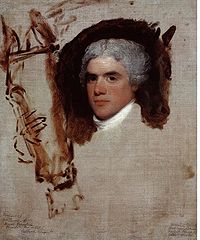Annotation:Rickett's Hornpipe
X:0 T:Danced by Aldridge M:2/4 L:1/8 B:McGlashan - A Collection of Scots Measures (c. 1781, p. 35) N:Earliest appearance in print of Rickett's Hornpipe N:The 3rd measure in McGlashan's collection is garbled, and the N:fourth measure is missing altogether. The abc's below have been N:corrected. The 3rd measure in the collection goes: d/|e/d/c/B/ A/G/e/d/| Z:AK/Fiddler's Companion K:Bb V:1 clef=treble name="0." [V:1] F/G/A/|B/A/B/F/ D/F/B/d/|c/B/A/G/ F/A/c/e/|d/e/f/d/ g/f/e/d/| c/B/A/G/ F/F/G/A/| B/A/B/F/ D/F/B/d/|c/B/A/G/ F/A/c/e/|d/f/d/B/ c/e/c/A/|BBBz:| |:f/d/d/B/ B/d/d/f/|g/e/e/c/ A/c/c/e/|f/d/d/B/ g/e/c/B/|A/B/G/A/ F/e/d/c/| B/A/B/F/ D/F/B/d/|c/B/A/G/ F/A/c/e/|d/f/d/B/ c/e/c/A/|BBBz:|]
RICKETT'S HORNPIPE. AKA and see "Manchester Hornpipe (1) (The)," "New College Hornpipe (1) (The)," "One Eyed Fiddler," "Raker's Hornpipe," "Sailor's Hornpipe (2),” “Texarkana Hornpipe,” “Tomorrow Morning,” “Yarmouth Hornpipe." English, Irish, American; Hornpipe, Breakdown. USA; Arizona, Oklahoma, Arkansas, Alabama, Mississippi, Kentucky, West Virginia, Michigan, Pennsylvania, New York, New England. Canada, Ontario. D Major (most versions): C Major (Hardings). Standard or ADae (some Southern versions, e.g. Tommy Jarrell) tunings (fiddle). AABB.

The particular Rickett honored in the title was a circus promoter, one John Bill Ricketts [1] (1769-1800), a Scottish immigrant who came from England in 1792 and flourished in America through the 1790's until his Philadelphia enterprise was destroyed in a fire on Dec. 17, 1799. He reportedly delighted his audiences by dancing hornpipes on the backs of galloping horses [Ivan Tribe], and toward the end of his career hired another famous American hornpipe dancer, John Durang, to produce pantomimes for him. Alan Jabbour (in "American Fiddle Tunes") says that circuses under his name appeared in New York City, Philadelphia, Norfolk, Charlestown, Albany, Boston, Hartford, and Montreal.

The earliest appearance of the melody, finds Jabbour, was in Alexander McGlashan's Edinburgh-published Collection of Scots Measures of 1781, with the notation "danced by Aldridge," a reference to the great Irish-born dancer of the late 18th century Robert Aldridge (see note for "Aldridge's Hornpipe"). Krassen (1973) states that "Rickett's," common in the British Isles, is very popular in the Appalachians (albeit slightly less so than "Fisher's Hornpipe" which is easier to play), although in the South the tune lost all connections with the hornpipe dance, and is usually played at the same pace as a breakdown. Mike Yates (2002), however, demurs saying that “the tune was actually more popular in the northern cities and is one of the few tunes that is played in the south as a hornpipe.” Bayard (1981) agrees it is an "exceedingly well-known" hornpipe whose title is almost invariably the same, and that it was as popular with fifers in Pennsylvania as fiddlers. It was also popular with northeastern U.S. fiddlers, notes Bronner (1987), who says that by the 1850's it was a common selection for fiddle-tune collections. It retained its popularity into the 20th century and was cited as having frequently been played for country dances in Orange County, New York, in the 1930's (Lettie Osborn, New York Folklore Quarterly). At mid-century it was one of the tunes often in the repertories of amateur fiddlers throughout the country, as, for example with Buffalo Valley, Pa., region dance fiddlers Ralph Sauers and Harry Daddario. Patrick Bonner, a fiddler from Beaver Island, Michigan, recorded the tune on 78 RPM for the Library of Congress. Bonner was the youngest son of immigrants from Arranmore Island, County Donegal (Beaver Island was destination for a number of Arranmore families), and the Donegal fiddle tradition can be heard in his playing. It was even recorded on a 78 RPM by the Irish-American group Dan Sullivan’s Shamrock Band. The tune was recorded for the Library of Congress by musicologist/folklorist Vance Randolph from Ozarks Mountains fiddlers in the early 1940's, for the same institution by Herbert Halpert from Mississippi fiddler Stephen B. Tucker (b. 1859) in 1939 (under the title "Raker's Hornpipe"), and in 1937 from the playing of Luther Strong (Hazard, Kentucky). It was played by R.L. Stephens of Camp Hill, Alabama, at a contest in Columbus, Georgia, according to the Columbus Enquirer of December 10 & 12, 1926 (Cauthen, 1990). One Georgia band heard on mid-1920’s radio playing “Rickett’s Hornpipe” consisted of a pair of uncles and a pair of nephews; the uncles were fiddlers Newt and Ed Tench, aged sixty-four and sixty-one years of age, who claimed to have been playing the fiddle for forty-five years or more. According to the newspaper the Atlanta Journal, they had “an enviable reputation as musicians in the mountain districts of Georgia,” and they had fiddled together so long that “harmony between the two is merely a matter of second nature.” (quoted by Wayne W. Daniel, Pickin’ on Peachtree, 1990, p. 54).
Versions of “Rickett’s” are still quite common among traditional musicians in southern England, where it’s usually called “Pigeon on the Gate” or “We'll Sit Upon the Gate.”
